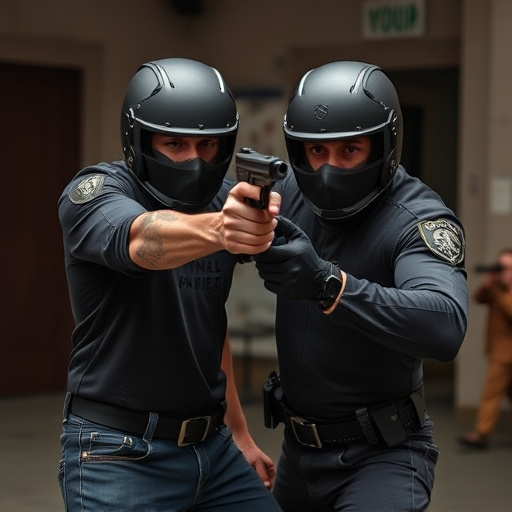The strongest legal pepper spray concentration, typically 10% capsaicin, offers civilians a powerful and effective non-lethal defense option. Governed by regional regulations, this concentration provides temporary immobilization without permanent harm. When selecting or using pepper spray, it's crucial to understand local laws, handle the spray responsibly, and prioritize safety to ensure personal protection in various scenarios.
In an era where personal safety is paramount, understanding the power of inflammatory spray stands as a key step for civilians seeking protection. This article delves into the world of pepper spray, exploring its historical roots and legal status in civilian hands. We dissect labeling to demystify what ‘strongest legal concentration’ truly means. Furthermore, real-life applications and effectiveness are examined, along with safety considerations crucial for responsible use. Discover how the right pepper spray can be a game-changer, empowering individuals to defend themselves effectively.
- Understanding Pepper Spray: Its History and Legal Status for Civil Protection
- Decoding Labeling: What Does Strongest Legal Concentration Really Mean?
- Application and Effectiveness: How Pepper Spray Can Be Used in Real-Life Scenarios
- Safety Considerations and Responsible Use: Protecting Yourself and Others
Understanding Pepper Spray: Its History and Legal Status for Civil Protection
Pepper spray, a powerful non-lethal self-defense tool, has become an iconic symbol of personal protection. Its history dates back to the 1980s when law enforcement agencies started using it as a less-lethal alternative to firearms. Over time, its civilian use gained popularity, especially among individuals seeking effective yet legal means for self-defense. The key active ingredient in pepper spray is capsaicin, derived from chili peppers, which stimulates the body’s pain receptors and causes temporary disorientation and immobilization.
In terms of legal status, the regulations surrounding pepper spray vary widely across countries and even within regions. However, its widespread adoption has led to a standard for potency, with the strongest legal pepper spray concentration typically containing 10% capsaicin. This concentration is considered powerful enough to disable an assailant without causing permanent harm. Many civilian-grade pepper sprays on the market are designed to meet these legal standards, ensuring their legality while providing users with a robust defense mechanism.
Decoding Labeling: What Does Strongest Legal Concentration Really Mean?
When shopping for pepper spray, one of the most confusing aspects is understanding labeling and claims regarding strength. The term “strongest legal concentration” is often thrown around, but what does it really mean? It’s essential to decipher this phrase to make an informed decision about your personal safety. The legality of a pepper spray’s concentration varies by region, with different jurisdictions having distinct guidelines.
The strongest legal concentration refers to the capsaicin oleoresin concentration (OC) allowed under local laws. This measure indicates how much of the active ingredient is present in each spray. Typically, concentrations are expressed as a percentage, with higher numbers signifying more potent spray. However, always check your area’s specific regulations, as even within countries, state or provincial laws can differ, ensuring you’re compliant and effective in your self-defense choice.
Application and Effectiveness: How Pepper Spray Can Be Used in Real-Life Scenarios
Pepper spray, known for its strong legal pepper spray concentration, is a versatile self-defense tool that can be used in various real-life scenarios. When deployed, it creates a temporary yet powerful effect by irritating the eyes and respiratory system of the target, rendering them temporarily disabled. This gives users valuable time to escape or seek help. For instance, in a mugging attempt, a civilian carrying pepper spray can quickly activate it to disrupt the assailant’s attack, allowing for a safe retreat.
The effectiveness of pepper spray lies in its ability to cause a rapid response. The strongest legal pepper spray concentration is designed to immobilize an aggressor within seconds, providing enough time for the user to get away. In crowded public places, such as festivals or demonstrations, where potential threats might arise, civilians equipped with pepper spray can ensure their personal safety while enjoying the event. This non-lethal weapon offers a reliable layer of protection, making it an excellent choice for individuals prioritizing their security in diverse environments.
Safety Considerations and Responsible Use: Protecting Yourself and Others
When considering an inflammatory spray for civilian protection, safety considerations and responsible use are paramount. It’s crucial to understand that while these devices offer a powerful tool for self-defense, they also come with inherent risks. The strongest legal pepper spray concentration, typically measured in capsaicin units (CU), should be used judiciously to minimize potential harm to yourself and others.
Responsible use includes adhering to local laws and regulations regarding the possession and application of pepper spray, as well as receiving proper training on its safe deployment. It’s essential to familiarize yourself with the spray’s range, effective duration, and any de-escalation techniques to avoid unnecessary confrontations or accidental exposure. Always keep the spray in a secure, inaccessible location for children and untrained individuals to prevent misuse.
When it comes to civilian protection, understanding the strongest legal pepper spray concentration is key. As this article has explored, proper labeling and knowledge of application techniques are vital for effective self-defense. By recognizing the potential risks and adhering to responsible use guidelines, individuals can leverage the power of pepper spray as a legitimate deterrent in real-life scenarios. Remember, informed decisions save lives.
